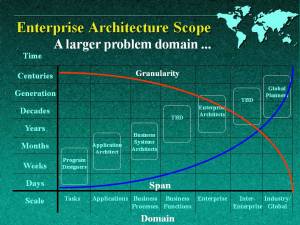Structure in Threes: Chapter 1: An Architect’s View of Organizations – creating a coordinate system for an abstract space
September 17, 2013 1 Comment
Laying out the problem for a enterprise architecture coordinate system
As I start laying out the intellectual underpinning of the book I go back to discussions I had with my friend and mentor John Zachman who arguably coined the term and discipline Enterprise Architecture with his framework paper. During those discussions I was keen to ask if he had identified the coordinate system (dimensions) that the framework displays as views or calls out the necessity to have plans for? The answer was no with a challenge back to me to do the investigation for such.
Having been a student of residential architecture prior to my migration into the business and information technology fields I was well versed in the paradigm of physical space; 3D. When specifying the physical design of a dwelling –prior to CAD/CAM systems– one would make drawing that collapsed the three dimensional world onto a two dimensional plane; a drawing. With two drawings –that is each had one common dimension and one dimension that was orthogonal to the others– one could create another view that displayed the relationship between the orthogonal two dimensions through projection, thus giving the viewer a perspective that was hidden from sight. Additionally, one could also create auxiliary views that were not perfectly orthogonal, giving more insight to areas of concern.
The problem with applying this physical space analogy in the business and information technology problem space was that the dimensions did not use the same metric space. That is length, width, and depth all use the measurement units be they inches, centimeters, or whatever. In the business and information technology problem space there is no common unit of measure. At this point some of my CFO friends point out that finance is the common unit. However, as I point out to them, its not common if its not common to all the views. Data or Process structure does is not measured in financial units. This was a vexing issues to me for a number of years until I started researching physics and came to the interesting conclusion that the dimensions need not be measured in the same unit but that the metrics only need to be related in some deterministic manner.
While I have not completed my research on the actual measurement system, I have managed to come to grips with a conceptual model that has these dimensions at least connected in a probabilistic manner which is how I got into predictive analytics as a topic to include in the book. This was further validated when I went back to basic engineering concepts where solution space was examined using statistics. I refer to Taguchi’s Design of Experiments .
If I continue with my thought experiments applying physics concepts to business and information architecture I get to primitives like Space, Time, and Mass. However, these dimensions are hard to relate directly to business and information technology as well as lack coverage for abstracts such as finance and information. Does information have mass? Can one measure the space finance occupies? To quote a line from the movie I like, IQ, “Interesting concept”. But I don’t smoke. This has led me to another side project of build a information model of these dimensions which will be included in the appendix and discussed in the academic part of the book.












